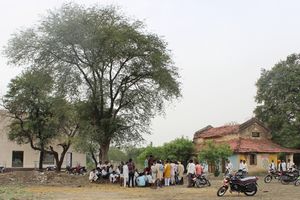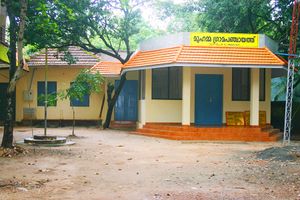پنچايتي راج
پنچايتي راج (Panchayat raj؛ هندي: पंचायती राज panchayat- "المجلس القروي"، raj "الحكم")، هو نظام سياسي، يرجع بأصوله إلى شبه القارة الهندية، يوجد بشكل رئيسي في الهند، پاكستان، بنگلادش، سريلانكا، ونيپال. وهو اقدم نظم الحكومة المحلية في شبه القارة الهندية، وتوجد له إشارات تاريخية تعود إلى 250 ق.م.[1] جلمة راج تعني "الحكم" بينما تعني پنچايت “المجلس ” (ايات) من (پنگا) الخمسة. كانت مجالس الپنچايت تتألف تقليدياً من الكبار الحكماء المختارين والمقبولين من قبل المجتمع المحلي. ومع ذلك، هناك أشكال مختلفة من هذه المجالس. تقليدياً، كانت مهمة هذه المجالس حل النظاعات بين الأفراد والقرى الأخرى.
عادة ما يُطلق على قائد الپنچايت موخيا، سارپنچ أو پرادان، المنصب المُنتخب أو المُعترف به بصفة عمة. يجب عدم الخلط بين پنچايتي راج الهند وپنچايت گرام مع النظم التقليدية الأخرى ولا پنچايت كاپ (أو الپنچايت الاجتماعية) الموجودة في مناطق أخرى بشمال الهند.[2]

دافع مهاتما غاندي عن پنچايتي راج كأساس للنظام السياسي الهندي. كان الپنچايتي راج هو شكل غير مركزي للحكومة حيث تكون كل قرية مسئولة عن شئونها الخاصة.[3][4] كان مصطلح هذه الرؤية يُعرف باسم گرم سواراج ("الحكم الذاتي القروي"). بدلاً من ذلك وضعت الهند شكلا مركزيا للغاية من الحكم.[5] ومع ذلك ، فقد تم الإشراف على ذلك من خلال تطبيق اللامركزية في العديد من الوظائف الإدارية على المستوى المحلي، وتمكين الپنچايت گرام منتخبة.[6] هناك اختلافات كبيرة بين نظام الپنچايتي راج التقليدي، الذي يتخيله غاندي، والنظام الرسمي في الهند عام 1992.[7]
يوجد النظام أيضاً في ترينيداد وتوباگو.[8][9][10]
. . . . . . . . . . . . . . . . . . . . . . . . . . . . . . . . . . . . . . . . . . . . . . . . . . . . . . . . . . . . . . . . . . . . . . . . . . . . . . . . . . . . . . . . . . . . . . . . . . . . . . . . . . . . . . . . . . . . . . . . . . . . . . . . . . . . . . . . . . . . . . . . . . . . . . . . . . . . . . . . . . . . . . . .
انظر أيضاً
المراجع
- ^ P.B. Udgaonkar, Political Institutions & Administration, Motilal Banarasidass Publishers, 1986, ISBN 978-81-20-82087-6, https://books.google.com/books?id=Jdoym34QydQC&pg=PA210, "... these popular courts are first mentioned by Yajnavalkya and then by Narada, Brishaspati, Somadeva and Sukra. These writers covered a period of about a thousand years, c. 100 to 1950 A.D., and they could not have mechanically referred to the popular courts if they were not actually functioning ..."
- ^ Mullick, Rohit; Raaj, Neelam (9 September 2007). "Panchayats turn into kangaroo courts". The Times of India.
{{cite news}}: Unknown parameter|lastauthoramp=ignored (|name-list-style=suggested) (help) - ^ Sisodia, R. S. (1971). "Gandhiji's Vision of Panchayati Raj". Panchayat Aur Insan. 3 (2): 9–10.
- ^ Sharma, Manohar Lal (1987). Gandhi and Democratic Decentralization in India. New Delhi: Deep and Deep Publications. OCLC 17678104. Hathi Trust copy, search only
- ^ Hardgrave, Robert L.; Kochanek, Stanley A. (2008). India: Government and Politics in a Developing Nation (seventh ed.). Boston, Massachusetts: Thomson/Wadsworth. p. 157. ISBN 978-0-495-00749-4.
{{cite book}}: Unknown parameter|lastauthoramp=ignored (|name-list-style=suggested) (help) - ^ Pellissery, S. (2007). "Do Multi-level Governance Meet Local Aspirations?". Asia Pacific Journal of Public Administration. 28 (1): 28–40.
- ^ Singh, Vijandra (2003). "Chapter 5: Panchayate Raj and Gandhi". Panchayati Raj and Village Development: Volume 3, Perspectives on Panchayati Raj Administration. Studies in public administration. New Delhi: Sarup & Sons. pp. 84–90. ISBN 978-81-7625-392-5.
- ^ "The Panchayat system as an early form of conflict resolution in Trinidad. - GCSE History - Marked by Teachers.com". www.markedbyteachers.com.
- ^ "Carmona wants "Panchayat' system to resolve conflicts - Trinidad and Tobago Newsday Archives". 30 May 2016.
- ^ "Return of the panchayat - Trinidad and Tobago Newsday Archives". 12 May 2005.
للاستزادة
- Rajiv Balakrishnan, ed. (2007), Participatory Pathways: People's Participation in Development Initiatives, Pearson Education India, ISBN 978-81-317-0034-1, https://books.google.com/books?id=Chvak7Vu9xYC
